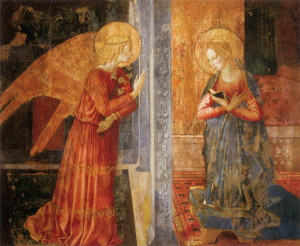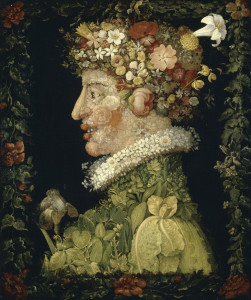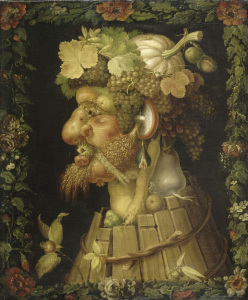
Just a few days past the Vernal Equinox each year comes the Feast of the Annunciation, which in earlier times was known best as Lady Day. It marks the day that the angel Gabriel came to Mary to deliver the news that she was to bear a child, a son, and that that child would be the light of the world, the son of God. We are nine months, at this point, to the Nativity.
We are nine months, as well, to the Winter Solstice, and this date has held significance for a very long time, long before Christianity. In the cyclical year, this is the season of opening (apero, as mentioned in our previous chapter, which gives its name to April), and rebirth. Mary conceives her child at this season magically, having “known not a man,” just as the earth goddess did at this same time of year. And so the Vernal Equinox brings both rebirth (the Green Man, leafing out in plants across the landscape) and conception (the Sun Child, who will be born at the Winter Solstice). The connections between Pagan and Christian roots are deep indeed.
March 25 was, for many, in the Old Style Julian Calendar, New Year’s Day. Again, this is all relative to the Vernal Equinox and the idea of fresh beginnings. And still the traditional Persian new year, Nowruz, is at this time of year. It begins on the equinox and continues on for 13 celebratory days. Mostly, the 25th of March has long been considered a mystical day in Judeo Christian tradition. It was considered by many through history as the first day of creation, the day of the expulsion from Eden, the day the Israelites passed through the Red Sea, the day of the beheading of John the Baptist, and the day of Christ’s crucifixion.
English folk custom considers it unlucky when Lady Day also happens to fall on Good Friday, which does happen on occasion. When it does, the Feast of the Annunciation is transferred to the Monday following the Second Sunday of Easter. But not many customs are associated with Lady Day. It is mostly set aside as a day of prayer. In Sweden, however, perhaps the most unlikely place for a Marian celebration, there is a long standing tradition of eating waffles on Lady Day, where the day is also known as Våffeldagen. Waffles are eaten at any time of day on Våffeldagen, breakfast, lunch, or dinner, served with whipped cream and lingonberries or cloudberries.
It is said that this waffle celebration all stems from one big misunderstanding. The Christian celebration of Lady Day is called, in Swedish, Our Lady Day, or Vårfrudagen… which, especially in some Swedish dialects, is awfully close in spelling and pronunciation to Våffeldagen, which translates to “Waffle Day.” And for centuries now, in addition to acknowledging Mary’s yes to the angel, Swedes all over the world have been eating waffles on the 25th of March. This, I say, is as good a reason as any to do the same.
Image: San Domenico Annunciation by Benozzo Gozzoli, tempera on wood, c. 1449, [Public domain], via Wikimedia Commons.


